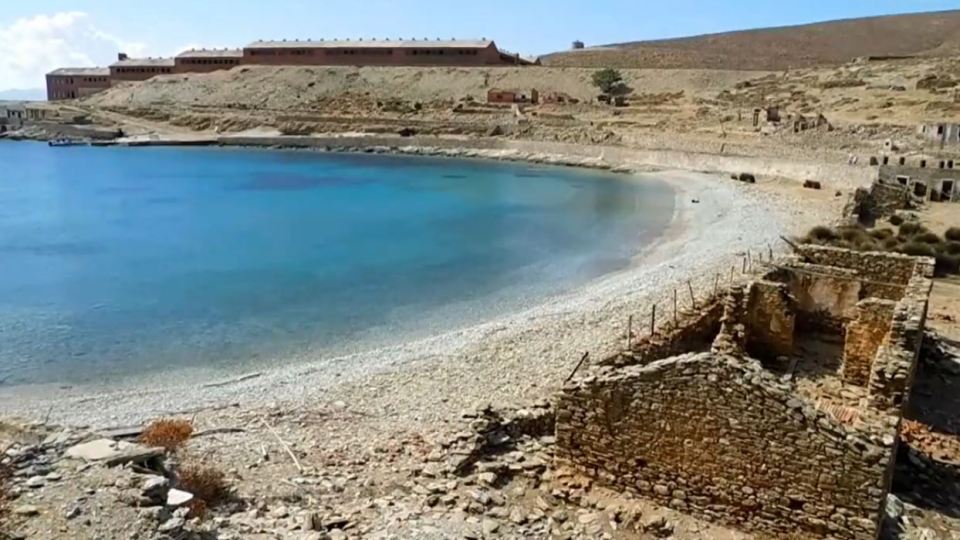THE GREEK island of Gyaros, dubbed the “Island of the Devil’, has sat deserted in the Aegean Sea for almost 50 years.
The only mark of human civilisation on its rocky shores is an enormous abandoned prison that used to hold thousands of exiled people.
A view of the abandoned prison on Gyaros island with crystal-clear blue waters and a white pebble beach
The eerie empty red-brick building comes into view as visitors sail inland
Visitors on a guided tour inspect a cemetery on the island
Part of the prison is seen close up on the rocky island shore
Aerial view over Gyaros island, northern CycladesGetty
The island, some 9 square miles big, sits isolated in the Aegan sea and is being touted as a potential new holiday hotspot.
In the early days of the Roman Empire it was used as a place for high-ranking people sent in exile, when they defied their rulers.
It was later used by the Greek Junta – a right-wing military regime – between 1967 and 1974 to punish political rebels.
The government used it for target range with the Hellenic Navy until 2000, but it is off-limits to the public and largely untouched.
The Greek Reporter describes it as a place of “exile and torture”.
Those imprisoned were tortured and made to do forced labour, with some referring to Gyaros as the “island of the devil”.
Now visitors are banned unless part of a sanctioned visit and the island is mostly home to the Mediterranean’s largest population of monk seals.
The eerie red brick prison perched on the cliffs of the island held some 10,000 men in custody between the years of 1948 and 1953.
North of the prison are the ruins of different camps where people would have to sleep year-round on the island.
Once a year, those who used to be imprisoned on Gyaros come to pay tribute to those exiled there for their political views.
Footage filmed there shows the stone relics left behind by the people who used to inhabit it.
Some stand in a cemetery with ancient stone grave markings and headstones.
The waters around the island, not far from Mykonos in the northern Cyclades, are a crystal-clear blue.
The island boasts crystal-clear waters – largely untouched as Gyaros is off-limits to the public
A view of the inside of the prison
The prison complex – complete with metal bars
Barbed wire was broken and twisted inside the wrecked prison
What appears to be the old toilets inside the deserted complex
Greek authorities are looking at turning it into a tourist destination, a mammoth project involving electricity, water, architecture and all other key infrastructure.
The World Wide Fund for Nature launched a campaign some 10 years ago to prevent trawler fishing and irreversible environmental damage to the island – home to many species of fish.
They said: “Gyaros is a unique place, an island where nature meets history.
“We wanted this island that was a place of exile and death to become an island of life and hope.”
Some Greeks are reluctant to see it turned into a holiday spot given the sensitive history of the island.
Roman senator Silanus, who ruled in 10 AD, was accused of treason and set to be banged up behind bars in the prison on Gyaros.
But because the island was considered “harsh and devoid of human culture”, he was sent instead to the nearby isle of Kythnos.
A Roman poet once described it as a place of exile for “particularly vile criminals” and a place of “claustrophobic imprisonment”.
Many were held there by the Junta because of their role in a political resistance.
Jehovah’s Witnesses were also sent there because of their objections to war.
An ancient grave stone marking
AlamyCell block in the prison complex[/caption]
AlamyThe front entrance leading to the gaurd house of Gyaros political prison[/caption]
AlamySentry tower and buildings in the prison[/caption]
Some of the ruins of the ancient camps

